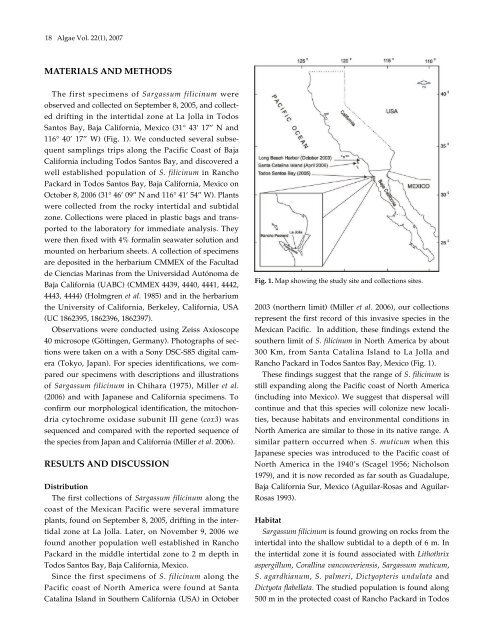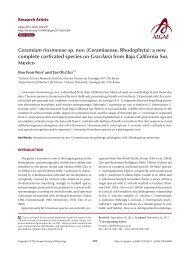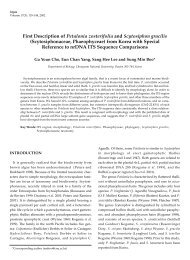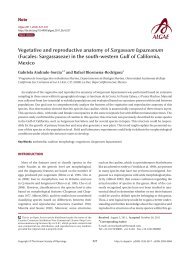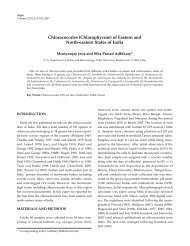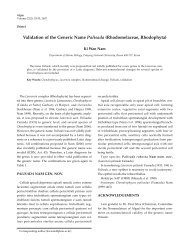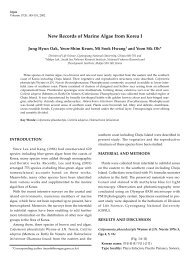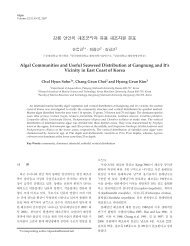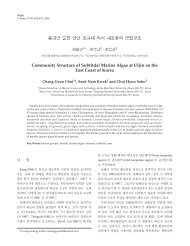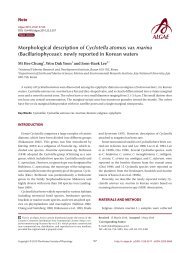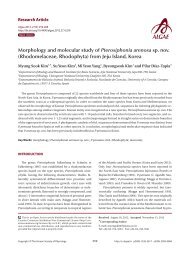New record of Sargassum filicinum Harvey (Fucales ... - Algae
New record of Sargassum filicinum Harvey (Fucales ... - Algae
New record of Sargassum filicinum Harvey (Fucales ... - Algae
You also want an ePaper? Increase the reach of your titles
YUMPU automatically turns print PDFs into web optimized ePapers that Google loves.
18 <strong>Algae</strong> Vol. 22(1), 2007<br />
MATERIALS AND METHODS<br />
The first specimens <strong>of</strong> <strong>Sargassum</strong> <strong>filicinum</strong> were<br />
observed and collected on September 8, 2005, and collected<br />
drifting in the intertidal zone at La Jolla in Todos<br />
Santos Bay, Baja California, Mexico (31° 43’ 17” N and<br />
116° 40’ 17” W) (Fig. 1). We conducted several subsequent<br />
samplings trips along the Pacific Coast <strong>of</strong> Baja<br />
California including Todos Santos Bay, and discovered a<br />
well established population <strong>of</strong> S. <strong>filicinum</strong> in Rancho<br />
Packard in Todos Santos Bay, Baja California, Mexico on<br />
October 8, 2006 (31° 46’ 09” N and 116° 41’ 54” W). Plants<br />
were collected from the rocky intertidal and subtidal<br />
zone. Collections were placed in plastic bags and transported<br />
to the laboratory for immediate analysis. They<br />
were then fixed with 4% formalin seawater solution and<br />
mounted on herbarium sheets. A collection <strong>of</strong> specimens<br />
are deposited in the herbarium CMMEX <strong>of</strong> the Facultad<br />
de Ciencias Marinas from the Universidad Autónoma de<br />
Baja California (UABC) (CMMEX 4439, 4440, 4441, 4442,<br />
4443, 4444) (Holmgren et al. 1985) and in the herbarium<br />
the University <strong>of</strong> California, Berkeley, California, USA<br />
(UC 1862395, 1862396, 1862397).<br />
Observations were conducted using Zeiss Axioscope<br />
40 microsope (Göttingen, Germany). Photographs <strong>of</strong> sections<br />
were taken on a with a Sony DSC-S85 digital camera<br />
(Tokyo, Japan). For species identifications, we compared<br />
our specimens with descriptions and illustrations<br />
<strong>of</strong> <strong>Sargassum</strong> <strong>filicinum</strong> in Chihara (1975), Miller et al.<br />
(2006) and with Japanese and California specimens. To<br />
confirm our morphological identification, the mitochondria<br />
cytochrome oxidase subunit III gene (cox3) was<br />
sequenced and compared with the reported sequence <strong>of</strong><br />
the species from Japan and California (Miller et al. 2006).<br />
RESULTS AND DISCUSSION<br />
Distribution<br />
The first collections <strong>of</strong> <strong>Sargassum</strong> <strong>filicinum</strong> along the<br />
coast <strong>of</strong> the Mexican Pacific were several immature<br />
plants, found on September 8, 2005, drifting in the intertidal<br />
zone at La Jolla. Later, on November 9, 2006 we<br />
found another population well established in Rancho<br />
Packard in the middle intertidal zone to 2 m depth in<br />
Todos Santos Bay, Baja California, Mexico.<br />
Since the first specimens <strong>of</strong> S. <strong>filicinum</strong> along the<br />
Pacific coast <strong>of</strong> North America were found at Santa<br />
Catalina Island in Southern California (USA) in October<br />
Fig. 1. Map showing the study site and collections sites.<br />
2003 (northern limit) (Miller et al. 2006), our collections<br />
represent the first <strong>record</strong> <strong>of</strong> this invasive species in the<br />
Mexican Pacific. In addition, these findings extend the<br />
southern limit <strong>of</strong> S. <strong>filicinum</strong> in North America by about<br />
300 Km, from Santa Catalina Island to La Jolla and<br />
Rancho Packard in Todos Santos Bay, Mexico (Fig. 1).<br />
These findings suggest that the range <strong>of</strong> S. <strong>filicinum</strong> is<br />
still expanding along the Pacific coast <strong>of</strong> North America<br />
(including into Mexico). We suggest that dispersal will<br />
continue and that this species will colonize new localities,<br />
because habitats and environmental conditions in<br />
North America are similar to those in its native range. A<br />
similar pattern occurred when S. muticum when this<br />
Japanese species was introduced to the Pacific coast <strong>of</strong><br />
North America in the 1940’s (Scagel 1956; Nicholson<br />
1979), and it is now <strong>record</strong>ed as far south as Guadalupe,<br />
Baja California Sur, Mexico (Aguilar-Rosas and Aguilar-<br />
Rosas 1993).<br />
Habitat<br />
<strong>Sargassum</strong> <strong>filicinum</strong> is found growing on rocks from the<br />
intertidal into the shallow subtidal to a depth <strong>of</strong> 6 m. In<br />
the intertidal zone it is found associated with Lithothrix<br />
aspergillum, Corallina vancouveriensis, <strong>Sargassum</strong> muticum,<br />
S. agardhianum, S. palmeri, Dictyopteris undulata and<br />
Dictyota flabellata. The studied population is found along<br />
500 m in the protected coast <strong>of</strong> Rancho Packard in Todos


